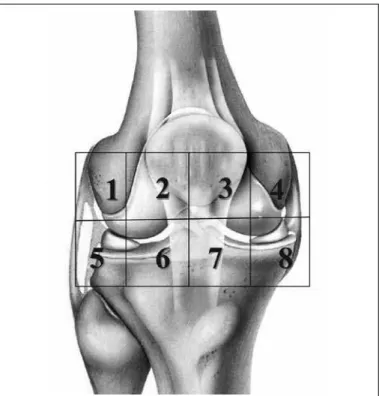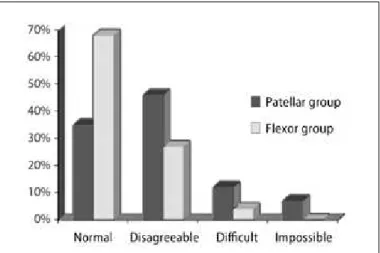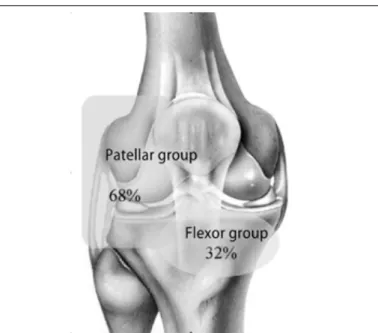INTRODUCTION
The anterior cruciate ligament (ACL) has the pri-mary function of impeding anterior displacement of the tibia. Injury to the ACL leads to a varying degree of symptomatic instability and high incidence of as-sociated lesions caused by changes to knee joint ki-nematics, and also prematurely predisposes the knee to joint degeneration processes(1).
Improvements in surgical techniques for recon-structing this ligament have made the procedures
7 artigo 251
oRIgINAL ARTICLE
The authors declare that they did not have any conflict of interests in producing this article
1 – Attending Physician in the Knee Group, Hospital São Rafael, Salvador, Bahia. Fellow at the West Lyon Orthopedics and Traumatology Surgery Center, Lyon, France (COROLYON).
2 – Resident Physician in the Orthopedics Service, Hospital São Rafael, Salvador, Bahia. 3 – Head of the Orthopedics Service, Hospital São Rafael, Salvador, Bahia.
4 – Assistant Head of Clinical Medicine, West Lyon Orthopedics and Traumatology Surgery Center, Lyon, France (COROLYON).
Work performed at Hospital São Rafael, Salvador, Bahia, and at West Lyon Orthopedics and Traumatology Surgery Center, Lyon, France (COROLYON).
Correspondence: Hospital São Rafael - Avenida São Rafael 2152 - Salvador, Bahia. E-mail:wvasconcelos2003@yahoo.com.br 2. COROLYON, 8 Avenue Ben Gourion, 69009 - LYON, France. Email: corolyon@wanadoo.fr
Work received for publication: October 15, 2009; accepted for publication: March 9, 2010.
INFluENcE OF ANTERIOR PAIN ON RESulTS FROm ANTERIOR
cRucIATE lIGAmENT REcONSTRucTION
Wilson Vasconcelos1, Claudinei Santos2, Antonio Marcos Ferracini3, David Dejour4
ABSTRACT
Objective: To examine the impact of residual pain on functional outcomes two years after arthroscopic anterior cruciate ligament (ACL) reconstruction and compare the types of graft used during the procedure (patellar vs. flexor). Method: A retrospective epidemiological study on 129 ACL reconstructions with a mean follow-up of 28 months was conducted. The presence, intensity and location of the anterior pain were investigated. Pain provocation tests were conducted, sensitivity was analyzed and functional scores were applied (IKDC, femoropatellar and SF-36), comparing the results with the type of graft used. Results: Anterior pain was present in 28% of patients with a mean intensity of 2.9 in 10.
When pain was present, the functional scores decreased significantly. Abnormalities of knee sensitivity and gait occurred frequently with use of the patellar tendon, but there was no statistical difference regarding the presence of pain. Conclusion: The presence of anterior pain in ACL reconstructions, even if minimal, has a deleterious effect on the final outcome over the medium term. Because of the influence of graft harvesting on the presence of abnormalities of knee sensitivity and gait, choosing the graft should take into account the patient’s professional and sports activities.
Keywords – Anterior Cruciate Ligament; Pain; Patellar Ligament
gathered: anamnesis; surgical characteristics (sta-tus of the joint cartilage, associated movements and complications); subjective information on the pain (presence and intensity on a numerical scale from 0 to 10 and topographic location on a tracing) (Figure 1); objective information on the pain (walking on knees) (Figure 2); information on touch sensitivity (topo-graphic location and intensity (Figure 1) and scores (subjective IKFC, subjective IKDC, femoropatellar LILOAS and the SF-36 quality-of-life score).
Rev Bras Ortop. 2011;46(1):40-4
The items that contribute towards satisfactory evolution of the procedure are: appropriate choice of surgical technique for each patient; the condition of the secondary restrictors (meniscus and ligaments), the postoperative analgesia used and safe early re-habilitation. Improvements and innovations in ACL reconstruction techniques have made it possible to achieve satisfactory results with regard to control over instability and early return to sports(3). Among the
most frequent complications from ACL reconstruc-tion, pain on the anterior face of the knee and residual muscle strength deficit seem to be connected with the choice of donor source(4-6).
The aim of this study was to analyze the impact that residual pain has on functional results, two years after arthroscopic ACL reconstruction, comparing the use of grafts from the central third of the patellar liga-ment with the use of grafts from the flexor tendons of the semitendinosus and gracilis muscles.
METHODS
In this series, 129 patients who underwent ACL ligament reconstruction were evaluated descriptively and retrospectively. Sixty-eight patients were ben-efited through using the patellar tendon as the graft (patellar group) and 61 received grafts from the flexor tendons of the semitendinosus and gracilis muscles (flexor group). The patients were evaluated after an average follow-up of 28 months. The series was com-posed of 81 men and 48 women, and their average age was 27.8 years.
All the patients were operated by the same sur-geon, Dr. David Dejour, and were reassessed by the same examiner, Dr. Wilson Vasconcelos. The choice of donor source for the graft was made according to the sport practiced by the patient (Table 1). The inclu-sion criteria were that these were patients operated in the years 2005 and 2006, aged between 16 and 45 years, who did not present any associated ligament injury and did not have any injury in the contralateral knee. Patients were excluded if they had been fol-lowed up for less than 18 months or if they presented an advanced chondral lesion diagnosed at the time of the surgery. Associated meniscal movement was considered to be an exclusion criterion.
During the reassessment, the following data were
Figure 1 – Topographical location of the pain after ACL recons-truction.
Patellar group Flexor group
Football (soccer) Handball
Skiing Rugby
Volleyball Basketball
Judo Karate Tennis
Table 1 – Choice of graft according to type of sport practiced.
flexor group. The mean SF-36 score was 83/100 for the patellar group versus 80/100 for the flexor group. There were no statistically significant differences in these three scores.
Walking on the knees produced better results in the flexor group, given that 68% of these patients presented normal results in the test, versus only 35% in the patellar group (p = 0.01). This task was con-sidered to be impossible by 10% of the patients in the patellar group, versus none of the patients in the flexor group (Figure 3).
Figure 2 – Knee walking test. REsULTs
Overall in this series, 26% of the patients reported the presence of anterior pain; 45%, abnormalities re-garding walking on the knees; and 47%, sensitivity alterations. The mean pain intensity gauged by the pa-tients was 2.9 out of 10. The mean scores were: 90.4 out of 100 on the femoropatellar scale; 84/100 on the subjective IKDC; and 84/100 on the overall SF-36, while the physical SF-36 was 83/100 and the mental SF-36 was 80/100. For the patients with complains of residual pain, the femoropatellar score was 84, versus 93 for those without complaints of pain (p < 0.005). Likewise, the IKDC went from 84 to 78 (p < 0.05) in cases with pain and the physical SF-36 went from 83 to 78 (p = 0.01).
The frequency of anterior pain for the patellar ten-don group was 34%, while it was 27% for the flexor group (p = 0.03). On the other hand, the pain intensity classified by the patients was 2.1/10 in the patellar group, versus 3.3/10 for the flexor group (p = 0.004).
The most common location for pain in the patel-lar group was on the patelpatel-lar tendon (37%), whereas for the flexor group, the most common location was close to the tibial tunnel (51%), followed by on the patellar tendon (26%). The mean femoropatellar score was 90.5% for the patellar group, versus 91.5% for the flexor group. The mean score for the subjective IKDC was 84.1 for the patellar group and 83 for the
Figure 3 – Knee walking test in relation to the type of graft chosen.
With regard to sensitivity problems, hypoesthesia was found to be present in 68% of the patients in the patellar group, versus 32% in the flexor group (p < 0.001). Regarding topographical location, there was a difference: the patellar group presented a deficit at the side of the scar, while the flexor group showed abnormalities in the middle lower part of the scar (Figure 4).
into consideration the technique used, when pain was present, it was at a low level. In our series, the frequency of pain was greater in the patellar group than in the flexor group, but this difference was not statistically significant (p = 0.03). The primary cause of this pain is believed to be correlated with graft harvesting, given the topographical locations of the pains, which were more anterior for the patellar group and more medial for the flexor group. A large portion of the studies have reported that there was no differ-ence in the frequency of anterior pain, in comparisons between the two groups(7-12).
Between our two groups, there was a statistically significant difference in relation to walking on the knees. The flexor group showed better performance, which should be taken into consideration at the time of choosing the graft to be used in the reconstruction. For patients who, during their professional or sports activities support themselves with their knees on the ground, the flexor group will be a better choice. The literature confirms that techniques using the flexors are superior in this respect(7,9,10).
With regard to sensitivity abnormalities, recon-struction using the flexors is significantly less iatro-genic than with the use of the patellar tendon (0.001). There was a close correlation with the presence of pain and hypoesthesia. It was observed that, among the patients without sensitivity problems, only 18% presented pain. On the other hand, among the patients with hypoesthesia, 40% presented pain, which denotes imprinting of hypoesthesia over the residual pain. It is known that sensitivity problems originate from lesions of the infrapatellar branches of the medial saphenous nerve(13,14), and thus, minimizing the aggression during
graft harvesting will benefit such patients.
In our assessment of the two groups, one with reconstruction using the central third of the patellar ligament and the other with flexor tendons from the semitendinosus and gracilis muscles, with a minimum of two years of follow-up, there was no difference in terms of patient satisfaction, from the SF-36 ques-tionnaire, subjective IKDC evaluation, femoropatellar score and pain analysis using a numerical scale. The literature also shows that neither group was better regarding patient satisfaction(7,15-17).
In our study, the pain levels reported by the pa-tients were low, as also found by Aglietti et al(18).
Figure 5 – Relationship between pain and sensitivity abnormalities.
Figure 4 – Topographic location of hypoesthesia.
Rev Bras Ortop. 2011;46(1):40-4
DISCUSSION
Analysis on the frequency of anterior pain leads to a variety of interpretations, in view of the subjective nature of such pain. In most studies, these data are gathered according to the authors’ analyses, thereby giving rise to considerable differences. In our series, in order to avoid the observer’s influence regarding the frequency and intensity of the pain, the criterion adopted was a positive response from the patient to the question: “Do you have any pain in the front of your knee?”
However, even though this pain was low, it signifi-cantly decreased the subjective IKDC, femoropatel-lar and SF-36 scores. Thus, the result was related to the presence of such pain. Seeking to achieve lower morbidity in graft harvesting will have a direct reper-cussion on the patient satisfaction rate.
CONCLUSION
The presence of anterior pain in ACL
reconstruc-tions, even if at low levels, has a deleterious effect on the final result over the medium term. The cause of this pain is multifactorial, but there is an impor-tant neuropathic contribution relating to the morbidity caused through graft harvesting. Because of the influ-ence of this harvesting on the presinflu-ence of sensitivity abnormalities and on walking on the knees, the choice of graft should take into account the patient’s profes-sional and sports activities.
REFERENCEs
1. Andrade MAP, Brandão GF. Osteoartrose do joelho secundaria à instabilidade anterior: avaliação do tratamento. Rev Bras Ortop. 1995;30(5):311-4. 2. Camanho GL, Andrade MH. Estudo comparativo da reabilitação dos pacientes
submetidos à reconstrução do ligamento cruzado anterior com enxertos do terço médio do tendão patelar e com os dos tendões dos músculos flexores mediais do joelho. Rev Bras Ortop. 1999;34(9/10):513-8.
3. Camanho GL, Olivi R, Camanho LF, Munhoz MAS, Moura MC. Tratamento da lesão aguda do ligamento cruzado anterior. Rev Bras Ortop. 1997;32(5):34752. 4. Bach BR Jr, Jones GT, Sweet FA, Hager CA. Artroscopy-assisted anterior cru-ciate ligament reconstruction using patellar tendon substitution: two-to-four-year follow-up results. Am J Sports Med. 1994;22:758-67.
5. Kleipool AE, van Loon T, Marti RK. Pain after use of the central third of the patellar tendon for cruciate ligament reconstrucion. 33 patients followed 2-3 years. Acta Orthop Scand. 1994;65(1):62-6.
6. Franceschi JP, Potel JF. Réparation arthroscopique du ligament croisé antérieur: comparaison tendon rotulien versus tendons de la patte d’oie. Rev Chir Orthop Reparatrice Appar Mot. 2003;89(Suppl 5):66.
7. Eriksson K, Anderberg P, Hamberg P, Olerud P,Wredmark T. There are differen-ces in early morbidity after ACL reconstruction when comparing patellar tendon and semi-tendinous tendon graft. Scand J Med Sports. 2001;11(3):170-7. 8. Jansson K, Linko E, Sandelin J, Harilainen A. Prospective randomized study
of patellar versus hamstring tendon autografts for anterior cruciate ligament reconstruction. Am J Sports Med. 2003;31(1):12-8.
9. Aune A, Holm I, Risberg M, Jensen H, Steen H. Four-strand hamstring tendon autograft compared with patellar tendon-bone autograft for anterior cruciate ligament reconstruction. Am J Sports Med. 2001;29(6):722-8.
10. Kartus J, Ejerhed L, Sernert N, Brandsson S, Karlsson J. Comparison of traditio-nal and subcutaneous patellar tendon harvest. A prospective study of donor site--related problems after anterior cruciate ligament reconstruction using different graft harvesting techniques. Am J Sports Med. 2000;28(3):328-35.
11. Beard DJ, Anderson JL, Davies S, Price AJ, Dodd CA. Hamstrings vs. Patella tendon for anterior cruciate ligament reconstruction: a randomised controlled trial. Knee. 2001;8(1):45-50.
12. Biau DJ, Tournoux C, Katsahian S, Schranz PJ, Nizard RS. Bone-patellar ten-don-bone autografts versus hamstring autografts for reconstruction of anterior cruciate ligament: meta-analysis. BMJ. 2006; 332(7548):995-1001.
13. Drain O, Beaufils P, Thevenin Lemoine C, Boggione C, Katabi M, Charrois O, et al. Reconstruction du ligament croisé antérieur par transplant os-tendon--os: technique par double voie et prélèvement sous-cutané. Rev Chir Orthop Reparatrice Appar Mot. 2007;93(8):836-41.
14. Tsuda E, Okamura Y, Ishibashi Y, Otsuka H, Toh S. Techniques for reducing anterior knee symptoms after anterior cruciate ligament reconstruction using a bone-patellar tendon-bone autograft. Am J Sports Med. 2001;29(4):450-6. 15. Ibrahim SA, Al-Kussary IM, Al-Misfer AR, Al-Mutairi HQ, Ghafar SA, El Noor
TA. Clinical evaluation of arthroscopically assisted anterior cruciate ligament reconstruction: patellar tendon versus gracilis and semitendinosus autograft. Arthroscopy. 2005;21(4):412-7.
16. Ejerhed L, Kartus J, Sernert N, Köhler K, Karlsson J. Patellar tendon or se-mitendinosus tendon autografts for anteriorcruciate ligament reconstruction? A prospective randomized study with a two year follow-up. Am J Sports Med. 2003;31(1):19-25.
17. Eriksson K, Anderberg P, Hamberg P, Löfgren AC, Bredenberg M, Westman I, et al. A comparison of quadruple semitendinosus and patellar tendon grafts in reconstruction of the anterior cruciate ligament. J Bone Joint Surg Br. 2001;83(3):348-54.


